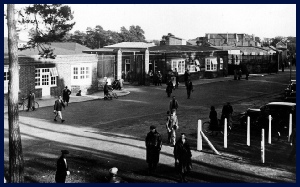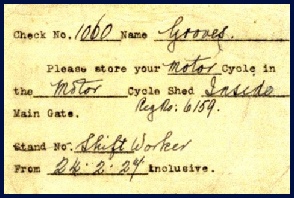
The Story of the
Holton Heath, Dorset, UK

Transport of Staff to and from RNCF
The Holton Heath site was situated on the northern shore of Poole Harbour with a railway passing by the southern edge and the A351 on its northern edge.
A station was built for the factory to allow staff to be able to travel from a wide area reaching Dorchester in the west, Swanage in the south, Blandford in the north and Christchurch and New Forest area in the east.
There were two platforms and two sets of overbridge steps connecting them. Trains served all three shifts and were often called “The Glamour Puffers” as the majority of their passengers were ladies. There were special tickets and fares.
There were very few cars or motor cycles at the beginning of WW1 - and petrol was even more limited - so many people cycled to work, the factory providing large areas of cycle sheds.
By John England

To help those who needed to travel in the dark on night and winter shifts who would have had acetylene cycle lamps, a small gas flame was provided outside the main gate in order that spills could be lit to transfer the flame to the acetylene lamp.
In WW2 cycle lamps were not permitted to be lit close the factory site.
The Main Gate
A copy of a pass for a motor cycle Registration Number 6159 to be permitted to be brought into the motor cycle shed inside the Main Gate was issued to Mr Groves, a Shift Worker on 24th February 1927 (see image). He was connected to the owners of the garage at the Holton Heath crossroads, known as the Heathwood Garage and run for many years by the Groves family who not only sold petrol and paraffin but did

repairs to bicycles and were kept very busy with those owned by RNCF employees.
Initially, those workers who used trains to get to work were issued with free, quarterly railway season tickets but about half of the workforce travelled by road and they quickly pointed out that they had travelling expenses too. The season tickets were therefore abolished after a year or so and all workers were granted a 2/- per week travelling allowance. Most of the road users were, of course, cyclists at that time.
Walking to work was the other alternative and many came from Wareham, Sandford, Lytchett Matravers, Upton and other neighbouring villages.
Once workers were inside the gates they walked to their building - or changing rooms if they were employed in the Danger Area - and then further walked to their production building still in their outdoor shoes or boots but then had to change at the ‘raised red line’ into their cordite shoes or moccasins. Staff visiting these buildings for only a short period for sampling or minor maintenance had to wear conducting rubber overshoes.
The superintendent had the benefit of a chauffeur and car to take him round the area and had staff to maintain his vehicle.